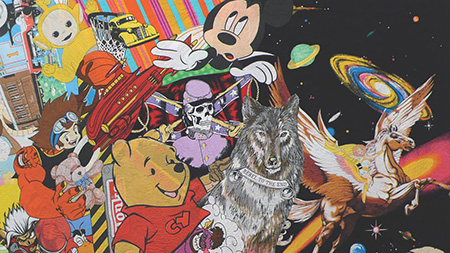
Continuing through September 29, 2018
“Beyond Beyond” spans more than 15 years of the Tokyo-born artist’s career, revealing the evolution of both the subjects she explores and the fabrics she uses. Based in Brooklyn and Istanbul, Turkey, Kijima’s art practice has always centered around the fusing of found textiles, acquired from thrift stores, flea markets and bazaars since adolescence, into masterfully executed quilts. The exhibition includes early works created with bits and pieces of sheets, towels, curtains and clothing. For the show’s earliest work, a 2002 piece titled “Erehwon” (“nowhere” spelled in reverse), the artist used primarily images from nature, including animals and plants. Like Japan’s Superflat movement, which called out the homogeneity fueled by commercialism and internet culture, Kijima pricks at the perils of commodification.
“Mom” (2008) and “Jane” (2009) signal a significant shift, appropriating widely and wildly from popular culture. The show includes several works from Kijima’s “Pop” series, featuring what the artist calls “chaotic collages.” Working with second-hand materials ranging from dish towels to vintage kimonos, they’re visually dense mash-ups of imagery pulled primarily from Eastern and Western pop culture sources, including Japanese anime, American cartoons, literature and television. For “Sun-Kissed Summer” (2012) from that series, her imagery brings together Barack Obama, a Teletubby and a Keebler elf. But there’s a decided shift by 2013, as seen in two works of that year from Kijima’s “New Love Plan” series. Both feature sexualized Japanese anime figures placed in a less crowded visual field. These works begin to question stereotypes of women more overtly.
By 2017, her work demonstrates a stronger graphic sensibility, and fascination with superhero culture. But there’s something radically new as well, rooted in the artist’s move to Istanbul, Turkey. In the markets there, she find scraps and borders of embellished textiles, which she incorporates into works that reference more traditional quilts. Six works comprise geometric shapes made with small fabric-covered circles. For “Velvet Diamond Pink” (2018), she uses Uzbek velvet, Uzbek Suzani, and Turkish block print. It’s a departure from Kijima’s earlier bodies of work, but there’s a common thread: making textiles as a means of self-expression and self-actualization.
